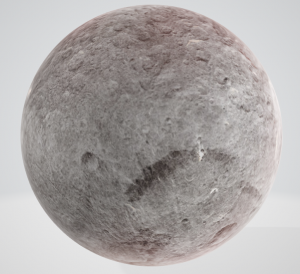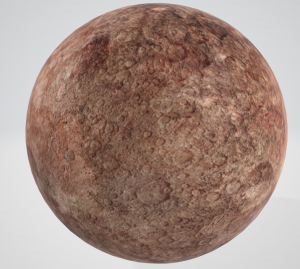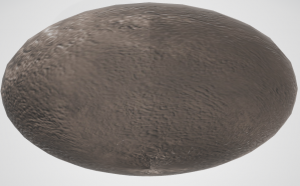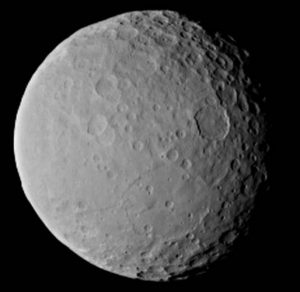There are five officially recognised dwarf planets (as of January 2020). In order of size they are: Pluto, Eris, Ceres, Haumea and Makemake.

When Eris was first discovered is was listed as the largest dwarf planet. This changed following the findings of Nasa’s New Horizon’s probe, which proved Pluto was the larger. Eris, however, may be heavier than Pluto (ie it has more mass), though it has the smaller diameter. All five dwarf planets have very eccentric orbits, and most of them wander around in the Kuiper Belt. Ceres, however, lies in the asteroid belt in the interplanetary space between Mars and Jupiter.
Eris
Eris was discovered in 2005, and is almost as large as Pluto, but slightly more massive. It was first named Xena when discovered and was the first Kuiper Belt Object to be identified. It was later named Eris after the Greek goddess of strife and discord. Like Pluto it has a thin, tenuous atmosphere that collapses as the planet nears the sun but expands as it moves away. The body is a mixture of rock and ice with a surface coated in methane ice. Its surface temperature ranges from -246°C to -230°C. Like all dwarf planets it has a highly eccentric orbit ranging from some 5.6 billion kilometres to beyond the outer edge of the Kuiper Belt at 14.6 billion kilometres.
It was also discovered that Eris has a moon: Dysnomia, the daughter of Eris. The two of them are also classed as “scattered disc objects”.

Makemake
Makemake is named after the Polynesian creator of humanity and god of fertility. It was discovered in 2005. With a diameter of 1 500 kilometres it ranks third behind Pluto and Eris in size. Its orbital period is 309.9 years at an average distance from the sun of 6 850 million kilometres. But like all dwarf planets this belies the expected eccentric orbit ranging from some 5.8 billion kilometres closest to the sun to 7.9 billion kilometres at its furthest. It has a super shiny surface due to methane, ethane and nitrogen ices, which makes it unusually bright. The surface temperature is -239°C.
Makemake has one moon, estimated to be 160 kilometres in diameter.
Haumea
Haumea was discovered in 2004 and orbits at an average distance from the sun of 6 452 million kilometres. Again, its eccentric orbit ranges from 5.2 billion kilometres nearest the sun to 7.7 billion kilometres at its furthest point. It

is named after a Hawaiian goddess. Its surface temperature is -241°C. Orbital period is 283.3 years. Haumea would be a sphere were it not for its crazy axial spin. It is twice as long as it is wide because of this. A day on Haumea is less than four hours.
Haumea has two moons: Namaka and Hi’iaka.
Ceres
With an average orbital distance from the sun of 413.7 million kilometres Ceres stands apart from its cousins residing in the Kuiper Belt (they with Pluto are classed as trans-Neptunian objects). For Ceres lies far closer to the sun in the Mars-Jupiter interplanetary space—the Asteroid Belt. It is estimated Ceres accounts for one third of the entire mass of the asteroid belt. It was discovered much earlier too, in 1801. And at the time was classified as an

asteroid and the first of its kind. Of course, we now know better, and it has been promoted to dwarf planet status (after all it is spherical and it orbits the sun!). It consists mainly of rock, but with significant quantities of water ice. There is dense silicate material at its core and lighter minerals and ice near the surface. It has a diameter of 952 kilometres, the smallest of the four, and rotates about every nine hours. It orbits the sun in 4.6 Earth years.
| Eris | Makemake | Haumea | Ceres | |
|---|---|---|---|---|
| Discovered | 2005 | 2005 | 2004 | 1801 |
| Diameter | 2 600 kms | 1 500 kms | 1 436 kms | 952 kms |
| Mass | 17 x 1018 tonnes | 3 x 1018 tonnes | 4 x 1018 tonnes | 943 x 1015 tonnes |
| Day | 8 hours | 7.8 hours | 3.9 hours | 9 hours |
| Orbital period | 556 years | 310 years | 283 years | 4.6 years |
| Orbital inclination | 44.19° | 28.96° | 28.22° | 10.59° |
| Distance from the sun | ||||
| Perhelion | 5 650 million kms | 5 760 million kms | 5 190 million kms | 381 million kms |
| Aphelion | 14 600 million kms | 7 940 million kms | 7 710 million kms | 447 million kms |
Back to Top
By Nigel Benetton, science fiction author of Red Moon Burning and The Wild Sands of Rotar
Last updated: Tuesday, 31 March 2020